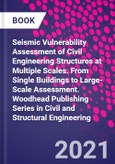Seismic Vulnerability Assessment of Civil Engineering Structures at Multiple Scales: From Single Buildings to Large-Scale Assessment provides an integrated, multiscale platform for fundamental and applied studies on the seismic vulnerability assessment of civil engineering structures, including buildings with different materials and building typologies. The book shows how various outputs obtained from different scales and layers of assessment (from building scale to the urban area) can be used to outline and implement effective risk mitigation, response and recovery strategies. In addition, it highlights how significant advances in earthquake engineering research have been achieved with the rise of new technologies and techniques.
The wide variety of construction and structural systems associated with the complex behavior of their materials significantly limits the application of current codes and building standards to the existing building stock, hence this book is a welcomed guide on new construction standards and practices.
Please Note: This is an On Demand product, delivery may take up to 11 working days after payment has been received.
Table of Contents
1. From single buildings to large-scale assessment
2. Survey and characterization techniques at different scales
Part 1: Building Scale
3. Challenges in the seismic assessment of RC structures: From pre-code buildings to recent ones
4. Seismic assessment of traditional masonry structures
5. Earthen structures
6. Timber and mixed structures
7. Steel structures
8. Seismic vulnerability of Industrial facilities
Part 2: Large Scale
9. Large scale vulnerability assessment and mitigation
10. Emergency planning at the urban scale
11. Risk assessment of transportation network systems
12. Building damage scenarios to support response and recovery








